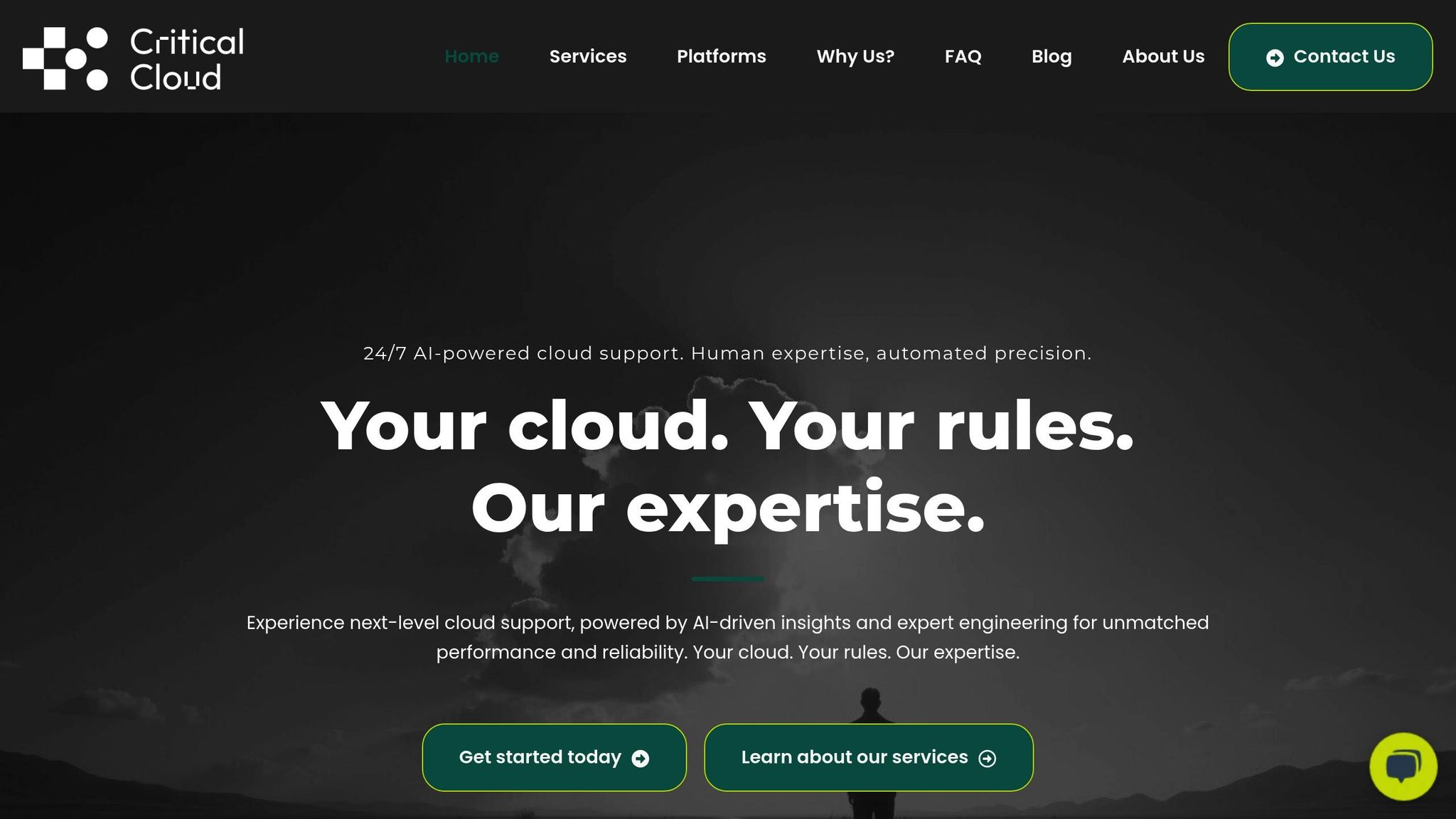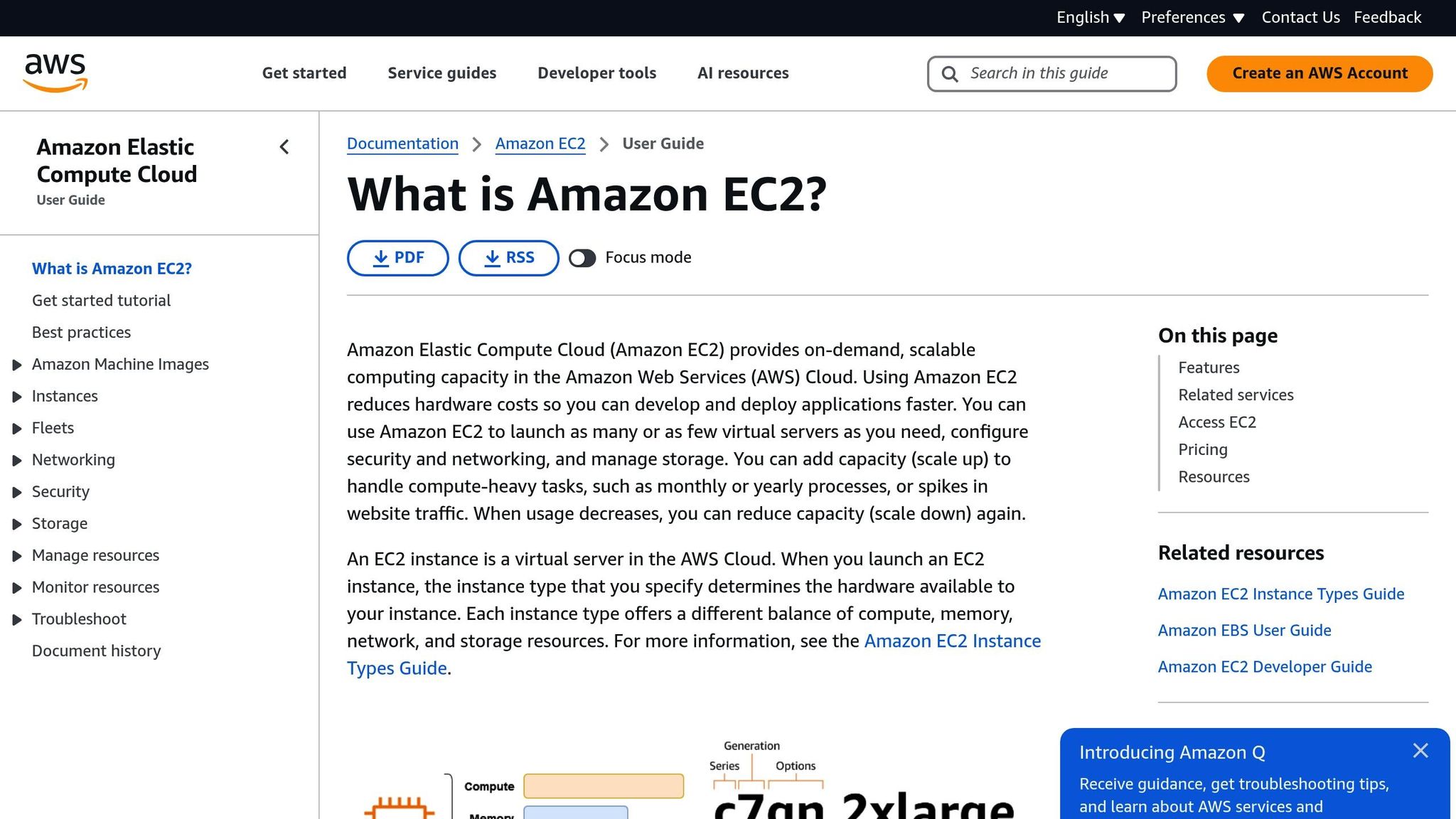How to Implement AI-Powered Cloud Monitoring
AI-powered cloud monitoring helps you detect and fix problems in your cloud systems before they cause issues. It uses machine learning to analyse data, predict issues, and automate tasks, saving time and reducing costs. Here's a quick summary:
- Why it matters: Minimises downtime, improves efficiency, and reduces operational costs.
- Key benefits for SMBs:
- Predictive Monitoring: Spots problems early.
- Automation: Handles routine tasks, freeing up your team.
- Cost Savings: Optimises resource use and lowers expenses.
- Steps to get started:
- Audit your current cloud setup (logging, alerts, performance metrics).
- Set clear performance goals and collect accurate data.
- Choose AI tools based on integration, scalability, and budget.
- Start with a small pilot project to test and refine.
| Traditional Monitoring | AI-Powered Monitoring |
|---|---|
| Reactive issue detection | Predictive issue detection |
| Manual resource allocation | Automated scaling |
| Higher operational costs | Lower costs with automation |
| Routine tasks for staff | Teams focus on strategy |
AI cloud monitoring transforms how businesses manage their systems, making it simpler, faster, and more efficient.
Setting Up Your Cloud Infrastructure
Checking Current Monitoring Setup
Start by documenting your existing monitoring setup, including logging, alert systems, and performance metrics.
Here’s a quick audit checklist:
| Component | Assessment Criteria | Action Required |
|---|---|---|
| Logging System | Centralisation, data quality, retention | Consolidate logs and standardise formats |
| Alert Configuration | Alert frequency, relevance, response time | Set precise thresholds |
| Performance Metrics | Coverage, accuracy, alignment with business goals | Identify monitoring gaps |
| Automation Level | Manual processes, workflow efficiency | Document automation opportunities |
Setting Performance Targets
Once the audit is complete, establish clear performance targets to guide your monitoring efforts.
Research highlights that organisations using AI to create new performance metrics are gaining an edge. For instance, 34% of companies already use AI in this way, with 90% reporting noticeable improvements.
- Define Core Objectives
Pinpoint and record the primary workload goals, supported by specific metrics. - Establish Service Level Indicators (SLIs)
Develop measurable indicators that reflect service performance, focusing on metrics tied to user experience and business results. - Set Service Level Objectives (SLOs)
Based on your SLIs, outline realistic targets that match both technical capabilities and business needs.
Data Collection Requirements
With performance targets in place, ensure your data collection system is reliable and well-integrated.
Accurate data collection is the backbone of effective AI monitoring.
Key components to focus on:
| Requirement | Purpose | Implementation Focus |
|---|---|---|
| Real-time Monitoring | Immediate issue detection | Continuous data streaming setup |
| Data Quality | Ensure accuracy via automation | Automated validation processes |
| Storage Infrastructure | Historical analysis | Scalable storage solutions |
| Integration Capabilities | Real-time data accessibility | API and connector setup |
Businesses that implement these strategies effectively are three times better at forecasting performance.
These steps lay the groundwork for scalable, cost-efficient AI-driven cloud monitoring tailored to small and medium-sized businesses.
Choosing AI Monitoring Tools
Tool Selection Criteria
When picking an AI monitoring tool, consider these key factors:
| Selection Factor | Evaluation Criteria | Focus |
|---|---|---|
| Data Management | Quality and volume requirements | Check pre-defined data quality standards |
| Integration | Compatibility with existing systems | API connectivity |
| Scalability | Ability to handle growth | Resource allocation for expansion |
| Cost Structure | Fits within budget | Assess return on investment (ROI) |
| Support Quality | Expertise and response time | Meet service level expectations |
Choose tools that work smoothly with your current systems. As Artur Kmiecik, Head of Cloud and Infrastructure Delivery at Capgemini EE, explains: "Integration is vital for cloud monitoring tools to ensure comprehensive coverage across your infrastructure, allowing seamless data collection and analysis across platforms and services".
To streamline your selection process, create an assessment worksheet that includes:
- Monitoring gaps and key metrics
- Integration needs
- Budget considerations
- Future growth plans
This framework will help you zero in on the tools that align best with your operational needs.
How Critical Cloud can help

Critical Cloud offers a mix of automation and expert oversight, tackling common monitoring challenges and supporting efficient cloud operations.
Key features include:
1. Real-time Monitoring and Analysis
This feature ensures continuous monitoring with AI-powered anomaly detection, allowing you to spot and address issues before they escalate.
2. Intelligent Automation
Routine tasks are automated with oversight from experts. Research shows that AI customer support tools can automate about 70% of customer requests effectively.
3. Scalable Architecture
| Feature Category | Capability | Business Impact |
|---|---|---|
| Monitoring | 24/7 real-time tracking | Always-on visibility of systems |
| Analytics | AI-driven insights | Better, data-based decisions |
| Automation | Smart task handling | Less manual effort required |
| Integration | Multi-platform support | Unified monitoring experience |
Critical Cloud goes beyond basic monitoring by offering:
- Predictive analytics for better resource planning
- Automated responses to incidents
- Suggestions for performance improvements
- Cost analysis for operational efficiency
"Monitoring all aspects of your operation is impossible. New AI tools can help you create accurate financial forecasts, gauge consumer sentiment, and improve employee efficiencies".
Setting Up AI Monitoring
Anomaly Detection Setup
To set up AI-based anomaly detection, start by gathering a variety of cloud metrics:
- Server logs: Track error rates and response times.
- Application metrics: Monitor resource usage and throughput.
- Network traffic: Observe bandwidth usage and latency.
- User interactions: Analyse session patterns and request frequency.
Critical Cloud's AI system processes this data through several analytical layers. It adjusts detection thresholds based on historical patterns, helping minimise false alarms while keeping accuracy intact. Once anomalies are identified, set up alerts to ensure quick and precise responses.
Alert System Configuration
Alerts should provide timely, useful notifications without overwhelming your team. Set up severity levels - critical events like outages or security issues need immediate attention, while less urgent anomalies can allow for delayed responses. Use different notification channels based on the type and urgency of the incident to ensure the right team members are informed. For routine issues, implement automated responses to handle them efficiently without requiring manual input.
Tool Integration Steps
Once detection and alerts are in place, integrate AI tools with your existing systems by following these steps:
- Data Source Connection
Link your cloud services to Critical Cloud's monitoring platform. It supports multiple data formats and protocols, making the integration process smooth. - AI Engine Configuration
Set up the AI engine to analyse your specific workloads. As James Smith, founder of Critical Cloud, points out:"The AI engine continuously learns from historical data and remedial actions to improve its predictive capabilities and solutions".
- Validation and Testing
Test the system by validating data processing, fine-tuning thresholds, and confirming that alerts work as expected during an initial calibration period.
sbb-itb-424a2ff
How to use AI TOOLS to monitor AWS EC2 instances for CPU ...

Using AI Data for Cloud Management
AI-powered cloud monitoring offers actionable insights that can improve both the performance and cost efficiency of your cloud operations. Here's how you can use this data to its full potential.
Resource Planning with AI
AI tools analyse past usage patterns and predict future demands, helping you allocate resources more effectively. For example, Critical Cloud's AI system processes usage data to pinpoint peak times and resource needs, enabling accurate capacity planning.
According to McKinsey, AI-driven cloud management can lower costs by 20-30% while enhancing performance. This is achieved by:
- Automatically identifying idle resources
- Predicting capacity requirements
- Dynamically allocating resources
- Spotting cost irregularities
One healthcare provider cut over-provisioning by 30%, allowing for better resource use during high-demand periods. These insights also support real-time performance adjustments for ongoing optimisation.
AI Performance Adjustments
AI systems monitor key metrics and make automatic adjustments to maintain optimal performance. Critical Cloud's AI engine evaluates several factors:
| Metric Type | What AI Monitors | Automated Actions |
|---|---|---|
| Server Performance | CPU, memory, storage usage | Resource scaling, load balancing |
| Network | Bandwidth, latency, throughput | Traffic routing adjustments |
| Application | Response times, error rates | Service auto-scaling |
| Cost | Resource use, spending patterns | Budget optimisation |
For instance, a financial institution reduced idle resources by 20% by using automated infrastructure adjustments.
Machine Learning Refinements
AI doesn't just make adjustments - it learns and improves over time. As James Smith of Critical Cloud explains:
"AI enables dynamic scaling and resource allocation, leading to cost savings and improved efficiency".
By continuously refining its predictions and responses, the system becomes more accurate. It:
- Establishes performance baselines
- Detects recurring patterns
- Improves prediction accuracy
- Adjusts to evolving workloads
A retail company saw a 25% reduction in cloud expenses within six months by using AI to identify and fix cost inefficiencies. This proactive monitoring helps prevent performance issues and ensures resources are used efficiently, keeping costs under control while maintaining high service levels.
Next Steps
Summary
Here are the main phases to focus on:
| Phase | Key Areas of Focus | Expected Results |
|---|---|---|
| Initial Phase | Validating data quality and testing integration | A solid base for precise AI analysis |
| Pilot Programme | Monitoring critical workloads and setting baseline metrics | Demonstrates value and assesses initial ROI |
| Full Deployment | Ongoing model training and workflow integration | Improved cloud operations |
Starting with a focused pilot project is a smart way to test the system while keeping risks and costs manageable. Many organisations succeed by targeting essential cloud resources first, allowing them to evaluate the AI monitoring system’s performance before committing to a full-scale rollout.
Start with Critical Cloud
To build on these principles, consider following this structured approach. Critical Cloud offers a clear path for small and medium-sized businesses, using intelligent automation to simplify assessments and make resource usage more efficient.
Here’s how to get started with AI monitoring:
- Assessment and Planning Take stock of your current cloud setup. The platform can help analyse your infrastructure to spot immediate optimisation opportunities and set clear monitoring priorities.
- Pilot Implementation Choose a specific workload for initial monitoring. This step helps you:
- Test how effective AI monitoring is
- Set performance benchmarks
- Fine-tune alert thresholds
- Build trust in AI-driven insights among your team
- Scale with Confidence After the pilot proves successful, expand monitoring to cover your entire cloud environment. The platform supports easy scaling while keeping costs under control through features like automated resource management, smart capacity planning, proactive performance tracking, and ongoing model updates.
Additionally, integrating human-in-the-loop automation ensures transparency and accountability in AI decisions, addressing a common concern for small and medium-sized businesses adopting these technologies.

.png?width=300&height=123&name=standard%20(2).png)